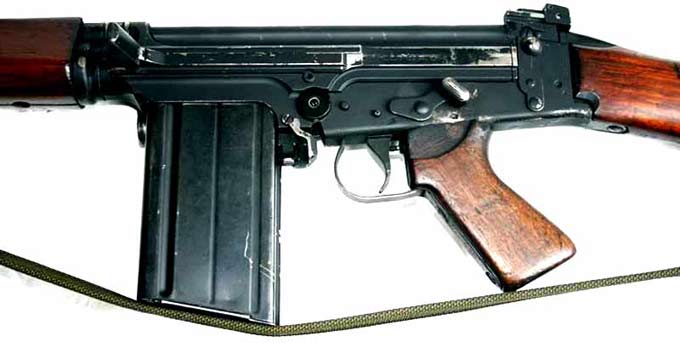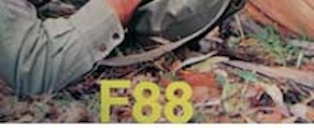History In 1947, the first FN FAL prototype was completed. It was designed to fire the intermediate 7.92x33mm Kurz cartridge developed and used by the forces of Nazi Germany during World War II (see StG44 assault rifle). After testing this prototype in 1948, the British Army urged FN to build additional prototypes, including one in bullpup configuration, chambered for their new .280 British calibre intermediate cartridge. After evaluating the single bullpup prototype, FN decided to return instead to their original, conventional design for future production.
In 1947, the first FN FAL prototype was completed. It was designed to fire the intermediate 7.92x33mm Kurz cartridge developed and used by the forces of Nazi Germany during World War II (see StG44 assault rifle). After testing this prototype in 1948, the British Army urged FN to build additional prototypes, including one in bullpup configuration, chambered for their new .280 British calibre intermediate cartridge. After evaluating the single bullpup prototype, FN decided to return instead to their original, conventional design for future production.
In 1950, the United Kingdom presented the redesigned FN rifle and the British EM-2, both in .280 British calibre, to the United States for comparison testing against the favored United States Army design of the time - Earle Harvey's T25. It was hoped that a common cartridge and rifle could be standardized for issue to the armies of all NATO member countries. After this testing was completed, U.S. Army officials suggested that FN should redesign their rifle to fire the U.S. prototype '.30 Light Rifle' cartridge. FN decided to hedge their bets and cast their lot with the U.S., given that the UK appeared to be favoring their own EM-2.
In 1951, FN even made a deal with the U.S. that they could produce the FAL royalty-free in the U.S. This decision appeared to be correct when the British unilaterally decided to adopt the EM-2 and .280 British cartridge in the very same month. This decision was later rescinded after the Labour Party was ousted from control of Parliament and Winston Churchill returned as Prime Minister. It is believed that there was a quid-pro-quo agreement between Churchill and U.S. President Harry Truman in 1952 that the British accept the .30 Light Rifle cartridge as NATO standard in return for U.S. acceptance of the FN FAL as NATO standard. The .30 Light Rifle cartridge was in fact later standardized as the 7.62 mm NATO; however, the U.S. insisted on continued rifle tests. The FAL chambered for the .30 Light Rifle went up against the redesigned T25 (now redesignated as the T47), and an M1 Garand variant, the T44. Eventually, the T44 won out, becoming the M14. However, in the mean time, most other NATO countries were evaluating and selecting the FAL.
FN created what is possibly the classic post-war battle rifle. Formally introduced by its designers Dieudonne Saive and Ernest Vervier in 1951, and produced two years later, it has been described as the "right arm of the Free World." The FAL battle rifle has its Warsaw Pact counterpart in the AK-47, each being fielded by dozens of countries and produced in many of them. A few, such as Israel and South Africa, manufactured and issued both designs at various times. Unlike the Russian AK-47 assault rifle, the FAL utilized a heavier full-power rifle cartridge. In the West, FAL's primary competitor was the German Heckler & Koch G3.
Design

The FAL operates by means of a gas-operated action very similar to that of the Russian SVT-40. The gas system is driven by a short-stroke, spring-loaded piston housed above the barrel, and the locking mechanism is what is known as a tilting breechblock. To lock, it drops down into a solid shoulder of metal in the heavy receiver like the bolts of the Russian SKS carbine and French MAS-49 series of semi-automatic rifles. The gas system is fitted with a gas regulator behind the front sight base, allowing adjustment of the gas system in response to environmental conditions, and can be closed completely to allow for the firing of rifle grenades. The FAL's magazine capacity ranges from 5 to 30 rounds, with most magazines holding 20 rounds. In fixed stock versions of the FAL, the recoil spring is housed in the stock, while in folding-stock versions it is housed in the receiver cover, necessitating a slightly different receiver cover, recoil spring, and bolt carrier.[1]
FAL rifles have also been manufactured in both light and heavy-barrel configurations, the heavy barrel intended for automatic fire. Most heavy barreled FALs are equipped with bipods, although some light barrel models were equipped with bipods.
Despite using a full-power .30 cartridge, the FAL's recoil is relatively light. This is due mainly to the rifle's weight, but also to its gas-operated design. In fully-automatic mode, however, the shooter receives considerable abuse from recoil, and the weapon climbs off-target quickly. Most military forces adopting the FAL eventually eliminated full-automatic firearms training in the light-barrel FAL.
Production and use
The FAL was made by Fabrique Nationale de Herstal (FN) in Liège, Belgium and under license in a number of countries, including the United Kingdom (as the L1A1 Self Loading Rifle or SLR), South Africa (where it was known as the R1), Brazil, Australia, Canada, Israel, Austria and Argentina. Mexico assembled FN-made components into complete rifles at its national arsenal in Mexico City. The FAL was also exported to many other countries, such as Venezuela, where a small-arms industry produces some basically unchanged variants, as well as ammunition. By modern standards, one disadvantage of the FAL is the amount of work which goes into machining the complex bolt and bolt carrier. Additionally, the movement of the tilting bolt mechanism tends to return differently with each shot, affecting inherent accuracy of the weapon. The FAL's receiver is normally machined, whilst most other modern military rifles use quicker stamping or casting techniques.
The Australian Army, as a late member of the allied rifle committee along with the United Kingdom and Canada adopted the committee's improved version of the FAL rifle, designated the L1A1 rifle by Australia and Great Britain, and the C1 by Canada. The Australian L1A1 is also known as the Self-Loading Rifle (SLR), and in full auto form, the Automatic Rifle (AR). The Australian L1A1 features are almost identical to the British L1A1 version of FAL, however the Australian L1A1 differs from its British counterpart in the design of the Main Body (Upper Receiver) lightening cuts. The lightening cuts of the Australian L1A1 most closely duplicate the later Canadian C1 pattern, rather than the simplified and markedly unique British L1A1 cuts. The Australian L1A1 FAL rifle was in service with Australian forces until it was supplanted by the F88 Austeyr in 1988.
The Australians, in co-ordination with Canada, developed a heavy-barrelled version of the L1A1 as an Automatic Rifle variant, designated L2A1. The Australian heavy-barrelled L2A1 was also known as the Automatic Rifle (AR). The L2A1 was similar to the FN FAL 50.41/42, but with a unique combined bipod, hand-guard and receiver/dust-cover mounted tangent rear sight. This L2A1 was intended to serve a role as a light automatic rifle or quasi-Squad Automatic Weapon (SAW). The role of the L2A1 is essentially the same in concept as the Browning Automatic Rifle (BAR) or Bren. The L2A1 often was considered a replacement for the BAR or Bren, although in practice many considered the L2A1 inferior to the BAR or Bren. It is noteworthy that most countries that adopted the FAL rejected the Heavy Barrel FAL, presumably because its "in-between" role served a need that really did not exist; and that it did not perform well as either a light rifle, or a SAW. Countries that did embrace the Heavy Barrel FAL included Argentina, Australia, Belgium, Canada, and Israel.
Unique 30 round magazines were developed for the L2A1 rifles. These 30-round magazines were essentially a lengthened version of the standard 20-round L1A1 magazines, perfectly straight in design. Curved 30-round L4A1 magazines from the 7.62 NATO caliber Bren Gun are interchangeable with the 30-round L2A1 magazines, however they reputedly have feeding difficulties due to the additional friction from the curved design as they must be inserted "upside down" in the L2A1 FAL. The L4A1 Bren magazines were developed as a top-mounted gravity-assisted feed magazine, opposite of what is required for the L2A1 FAL. Regardless of these shortcomings, the L4A1 magazines are popularly used in FAL rifles of all types. (The large front locking lug of inch pattern Commonwealth magazines is easily modified with a hand file to allow it to fit and function in FALs with metric receivers.)
The Australian L1A1/L2A1 rifles were produced by the Small Arms Factory, Lithgow, with approximately 220,000 L1A1 rifles produced between 1959 and 1986. L2A1 production was approximately 10,000 rifles produced between 1962 and 1982. Lithgow exported a large number of L1A1 rifles to many countries in the region. Notable users were New Zealand, Singapore, and Papua New Guinea.
Many Australian soldiers used the SLR rifle during the Vietnam War. Many Australian soldiers preferred the larger calibre weapon over the American M16 because they felt they could trust the NATO 7.62 round to kill an enemy soldier outright. Australian jungle warfare tactics during the Vietnam War were far more conservative than those employed by U.S. troops, and often determined by the strengths and limitations of the SLR and its heavy ammunition load. The SLR was semi-automatic only, unless battlefield modifications were made.
Another interesting product of Australian participation in the conflict in South-East Asia was the field modification of L1A1 and L2A1 rifles by the Australian Special Air Service Regiment SASR for better handling. Nicknamed "The Bitch". These rifles were field modified, often from heavy barrelled L2A1 automatic rifles, with their barrels cut off immediately in front of the gas block, and often with the L2A1 bipods removed and a XM148 40 mm grenade launcher mounted below the barrel. The XM148 40 mm grenade launchers were obtained from U.S. forces. For the L1A1, the lack of fully-automatic fire resulted in the unofficial conversion of the L1A1 to full-auto capability by simply filing down the selector.
Service history
In service 1953—present
Wars Vietnam War
Cambodian Civil War
Six-Day War
Portuguese Colonial War
the South African Border War
Northern Ireland Troubles
Rhodesian Bush War
Falklands War
Gulf War
Both Chechen Wars
Balkan Wars
Production history
Designer Dieudonne Saive, Ernest Vervier
Designed 1947-1953
Manufacturer Fabrique Nationale (FN)
Produced 1953—
Specifications
Weight 4.0–4.45 kg (8.8–9.8 lb)
Length 1,090 mm (43 in)
Barrel length 533 mm (21 in)
Cartridge 7.62x51mm NATO
Action Gas-operated, tilting breechblock
Rate of fire 650 rounds/min
Muzzle velocity 823 m/s (2,700 ft/s)
Effective range 500 meters
Feed system 20 or 30-round detachable box magazine
Sights Aperture rear sight, hooded post front sight





